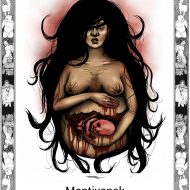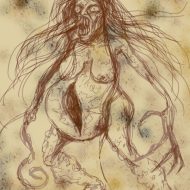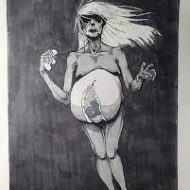Mantiyanak : The Pregnant Spirit
Listen
At a glance
| Description | |
|---|---|
| Origin | Philippine Mythology |
| Classification | Spirits |
| Family Members | N/A |
| Region | Philippines |
| Associated With | Murder, Evil |
Mantiyanak
Introduction
Mantiyanak, a captivating and menacing presence in Philippine mythology, holds a particularly prominent role in the folklore of Mindanao. This spectral entity is distinguished by a distinctive feature—a haunting abdominal cleft where her unborn child resides. Within the annals of folklore, the Mantiyanak carries a profound grudge against men, whom she holds responsible for her tragic destiny. Her enigmatic and ominous essence has continued to intrigue and terrify generations, making her a compelling testament to the intricate layers of Filipino mythology.
Physical Traits
The Mantiyanak’s appearance mirrors the chilling nature of her deeds. She is personified as a spectral figure bearing a distinct abdominal fissure, housing her unborn child. This physical trait serves as a perpetual symbol of the life she feels was robbed from her by the men who fathered her child. The Mantiyanak is frequently depicted as a grotesque and monstrous entity. Her visage is expressly crafted to instill fear in those who cross her path. Typically, she is illustrated as a horrifying woman with disheveled, unkempt hair, and elongated, menacing nails—a spine-tingling sight that is bound to evoke shudders. In some renditions, the Mantiyanak is described with razor-sharp fangs and eerie, glowing red eyes, further intensifying her capacity to terrify.
Family
The Mantiyanak, whose name is believed to have originated from the Tagalog word “mantiyad,” meaning “to crawl,” is an entity deeply rooted in the folklore of the Philippines. This malevolent spirit is said to be the vengeful ghost of a pregnant woman who died during childbirth. The legend holds that when a woman dies in this tragic manner, her spirit transforms into the Mantiyanak, seeking retribution against the living.
Powers and Abilities
The Mantiyanak firmly believes that she could have led a fulfilling life if she had not been impregnated by a man. This conviction fuels her vengeful disposition and propels her on a relentless quest for retribution against men. Her method of exacting revenge is gruesome; she prowls in the night, targeting men and viciously mutilating their genitals, causing them to bleed out. The legend of the Mantiyanak is a bone-chilling narrative that commences with the spirit cradling her belly protectively, ensuring the safety of her unborn child. She implores her unborn child not to follow in the footsteps of his father or other men who prioritize their desires and depart once satisfied.
With her resolve strengthened, the Mantiyanak embarks on her mission of vengeance, vowing to purge the world of callous men and promising to visit a unique brand of cruelty upon them. She holds these men accountable for the dire circumstances in which she finds herself and swears to take from them what they hold most dear: their manhood.
Modern Day Influence
The Mantiyanak stands as a bone-chilling presence in the realm of Philippine mythology. Her narrative stands as a poignant reminder of the far-reaching consequences of human actions, highlighting the deep pain that can stem from betrayal and abandonment. While she is a truly terrifying entity, the Mantiyanak also serves as a symbol of the profound suffering experienced by those who feel wronged and forsaken. Her tale carries a profound social message, questioning established norms and societal expectations, thus cementing the Mantiyanak’s enduring significance in Philippine folklore.
Furthermore, the Mantiyanak has transcended the realm of myth, making its mark in diverse mediums such as literature, cinema, and other forms of media. This has substantially contributed to the evolution of Filipino horror culture, elevating the Mantiyanak to an iconic status in the horror genre. Its influence extends not only within the Philippines but also beyond its borders, underscoring the global appeal and recognition of Filipino folklore.
Related Images
Frequently Asked Questions
What is lorem Ipsum?
I am text block. Click edit button to change this text. Lorem ipsum dolor sit amet, consectetur adipiscing elit. Ut elit tellus, luctus nec ullamcorper mattis, pulvinar dapibus leo.
What is lorem Ipsum?
I am text block. Click edit button to change this text. Lorem ipsum dolor sit amet, consectetur adipiscing elit. Ut elit tellus, luctus nec ullamcorper mattis, pulvinar dapibus leo.
What is lorem Ipsum?
I am text block. Click edit button to change this text. Lorem ipsum dolor sit amet, consectetur adipiscing elit. Ut elit tellus, luctus nec ullamcorper mattis, pulvinar dapibus leo.
What is lorem Ipsum?
I am text block. Click edit button to change this text. Lorem ipsum dolor sit amet, consectetur adipiscing elit. Ut elit tellus, luctus nec ullamcorper mattis, pulvinar dapibus leo.
What is lorem Ipsum?
I am text block. Click edit button to change this text. Lorem ipsum dolor sit amet, consectetur adipiscing elit. Ut elit tellus, luctus nec ullamcorper mattis, pulvinar dapibus leo.










